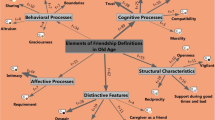Abstract
Continuity theory provides a rationalization for understanding older adult friendships. Older adults do not have to anticipate disengagement but can exercise their choice to actively participate in establishing and maintaining friendship structures. The role of friend is one a person can choose to maintain. Friendships are dynamic and progress on a continuum with beginnings, periods of endurance and change, and endings. Continuity theory provides ways to understand why particular people have developed and adapted distinct friendship and social support networks. This insight provides social service professionals, gerontologists, and family members ways to enable older adults to remain in their communities longer and maintain support stability.
Similar content being viewed by others
REFERENCES
Adams, R. G. (1998). Baby Boomer Friendships. Generations, 22(1), 70–75.
Adams, R. G. (1988). Which Comes First: Poor Psychological Well-Being or Decreased Friendship Activity? Activities, Adaptation & Aging 12(1/2), 27–41.
Adams, R. G. (1987). Patterns of Network Change: A Longitudinal Study of Friendships of Elderly Women. The Gerontologist, 27(2), 222–227.
Adams, R. G. (1985–86). Emotional Closeness and Physical Distance Between Friends: Implications for Elderly Women Living in Age-Segregated and Age-Integrated Settings. International Journal of Aging and Human Development 22(1), 55–75.
Allan, G. (1998). Friendship, Sociology and Social Structure. Journal of Social and Personal Relationships,15(5), 685–702.
Atchley, R. C. (1999). Continuity and Adaptation in Aging. Baltimore, MD: The John Hopkins University Press.
Atchley, R. C. (2000). Source Forces and Aging (9th ed.). Belmont, CA: Wadsworth Publishing Co.
Atchley, R. C. (1989). A Continuity Theory of Normal Aging. The Gerontological Society of America29(2), 183–190.
Blieszner, R. (1994). Close Relationships Over Time. In A.L. Weber & J.H. Harvey (Eds.), Perspectives on Close Relationships (pp. 1–17). Boston, MA: Allyn and Bacon.
Blieszner, R., & Adams, R. G. (1992). Adult Friendship. Newbury Park, CA: Sage Publications.
Brown, B. (1981). A Life-Span Approach to Friendship: Age-Related Dimensions of an Ageless Relationshp. In H. Z. Lopata (Ed.), Research in the Interweave of Social Roles (Vol. 2, pp. 23–50). Greenwich, CT: JAI Press, Inc.
Duck, S. (1983). Friends, for Life: The Psychology of Close Relationships. Brighton, Sussex: The Harvester Press Limited.
Fehr, B. (1996). Friendship Processes. Thousand Oaks, CA: Sage Publications.
Gottlieb, B. H. (1994). Social Support. In A.L. Weber & J.H. Harvey (Eds.), Perspectives on Close Relationships (pp. 307–324). Boston, MA: Allyn and Bacon.
Jones, D. C. & Vaughan, K. (1990). Close friendships among senior adults. Psychology and Aging, 5(3), 451–457.
Maggio, R. (1996). The New Beacon Book of Quotations by Women. Boston, MA: Beacon Press.
Matthews, S. H. (1986). Friendships Through the Life Course: Oral Biographies in Old Age. Beverly Hills, CA: Sage Publications.
Author information
Authors and Affiliations
Rights and permissions
About this article
Cite this article
Finchum, T., Weber, J.A. Applying Continuity Theory to Older Adult Friendships. Journal of Aging and Identity 5, 159–168 (2000). https://doi.org/10.1023/A:1009513304519
Issue Date:
DOI: https://doi.org/10.1023/A:1009513304519




